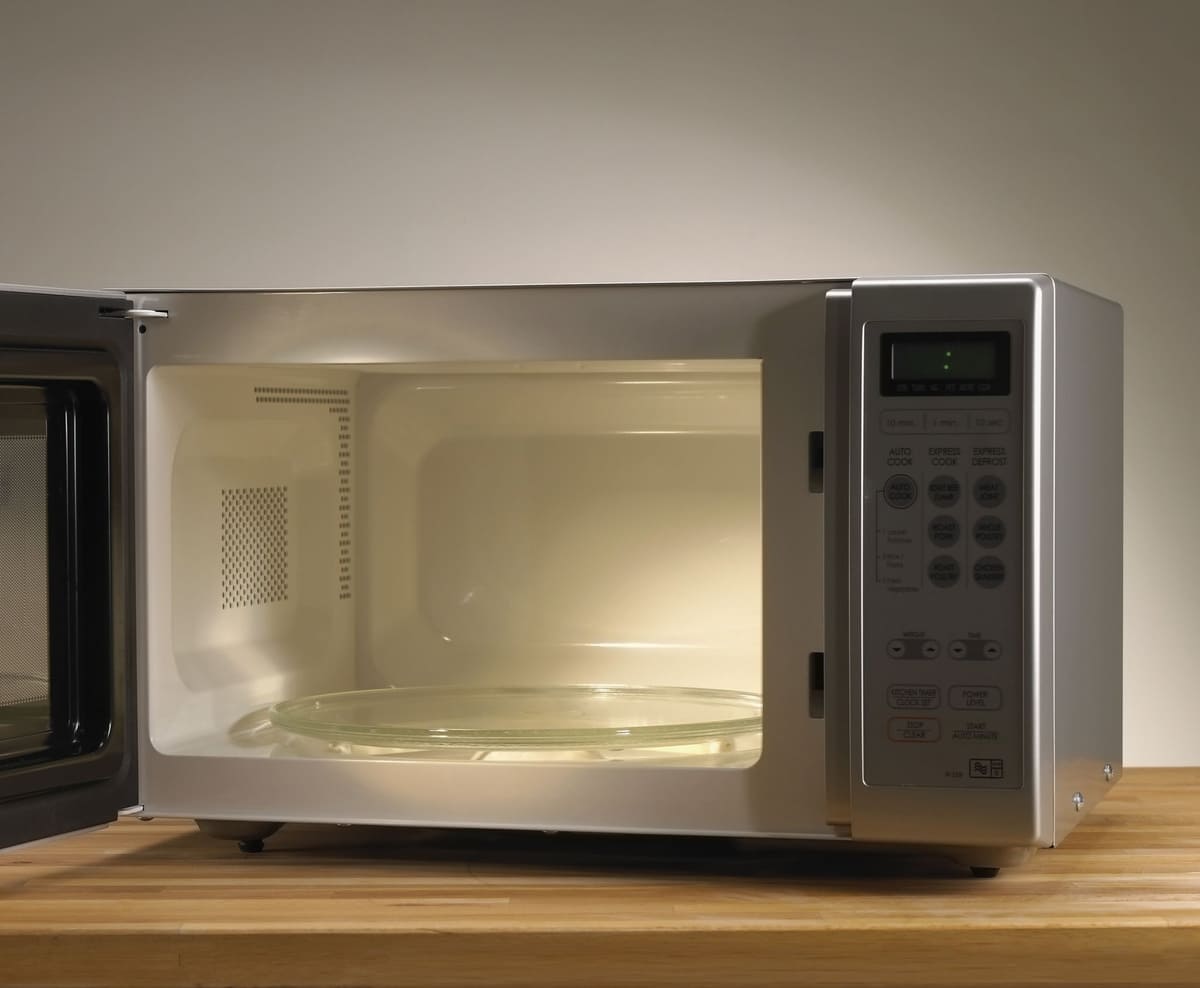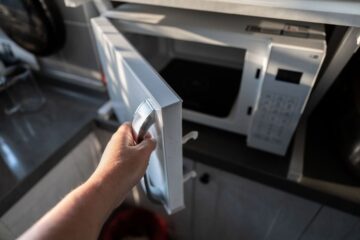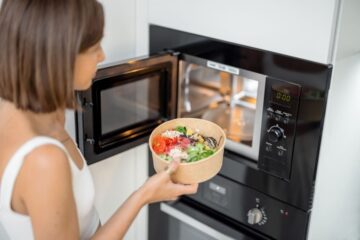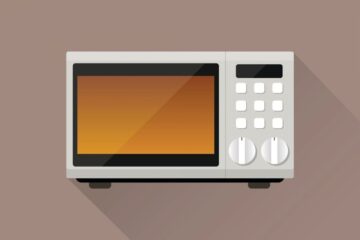Microwave ovens have become an essential kitchen appliance for many households. They offer a quick and convenient way to heat and cook food. However, one critical component of a microwave oven is often overlooked – the turntable. A microwave oven turntable is a rotating plate that sits at the bottom of the oven cavity. It plays a vital role in distributing heat evenly throughout the food, ensuring that it cooks or heats up uniformly. In this article, we will explore the different types of microwave oven turntables, their sizes, material options, and maintenance.
What is a Microwave Oven Turntable?
A microwave oven turntable is a rotating plate made of various materials such as glass, ceramic, metal, or silicone. It rotates within the microwave oven cavity to distribute heat evenly and ensure that food cooks uniformly. Microwave ovens are designed to heat food by producing electromagnetic waves that excite the molecules within the food, creating heat. The turntable helps to distribute this heat throughout the food, allowing it to cook or heat up uniformly.
Types of Microwave Oven Turntables
Microwave oven turntables come in different materials, and each material has its advantages and disadvantages.
- Glass Turntables
Glass turntables are the most common type of microwave oven turntable. They are usually made of tempered glass and have a smooth surface that is easy to clean. Glass turntables are also transparent, allowing users to monitor the cooking process without opening the oven door. However, glass turntables are fragile and can break if mishandled.
- Ceramic Turntables
Ceramic turntables are more durable than glass turntables and can withstand higher temperatures. They are also easy to clean and are dishwasher safe. However, ceramic turntables are more expensive than glass turntables.
- Metal Turntables
Metal turntables are the most durable type of microwave oven turntable. They are also non-porous, which means that they do not absorb food odors. Metal turntables are dishwasher safe and easy to clean. However, metal turntables can create arcing in the oven if they have any dents or scratches.
- Silicone Turntables
Silicone turntables are the newest type of microwave oven turntable. They are flexible and easy to clean. They are also non-stick, which means that food does not stick to the surface. However, silicone turntables are not as durable as other types of turntables and may not last as long.
Understanding Microwave Oven Turntable Sizes
The size of a microwave oven turntable is an important factor to consider when purchasing a microwave oven or replacing a turntable. A turntable that is too small for the oven cavity may not distribute heat evenly, while a turntable that is too large may not fit in the oven or hinder the door’s closure.
The Importance of Turntable Size
The turntable size determines the amount of food that can be cooked or heated in a microwave oven. A turntable that is too small for the oven cavity may not allow users to cook or heat up enough food, while a turntable that is too large may not fit in the oven or hinder the door’s closure.
Standard Microwave Oven Turntable Size
The standard size for a microwave oven turntable is 12 inches in diameter. This size is suitable for most microwave ovens that have an oven cavity size of around 1.5 cubic feet.
Large Microwave Oven Turntable Size
Microwave ovens with a larger cavity size will require a larger turntable. Large microwave oven turntables can measure up to 16 inches in diameter and can hold more substantial dishes.
Small Microwave Oven Turntable Size
Smaller microwave ovens typically have turntables that range from 10 to 12 inches in diameter. These are perfect for people who have limited counter space or who live in apartments or small homes. If you have a small microwave oven, it is important to choose a turntable that is appropriate for the size of the oven. Otherwise, you risk overloading the turntable and causing it to break or malfunction.
Choosing the Right Turntable for Your Microwave Oven
Now that we’ve covered the different types and sizes of microwave oven turntables, let’s discuss how to choose the right one for your microwave oven.
Matching Turntable Size with Oven Size
As we mentioned earlier, it is important to choose a turntable size that matches the size of your microwave oven. If the turntable is too big, it may not fit properly in the oven, causing it to wobble or even break. On the other hand, if the turntable is too small, it may not be able to accommodate larger dishes or plates.
Material Selection Based on Microwave Oven Use
The type of material you choose for your microwave oven turntable should also depend on how you plan to use your microwave oven. If you frequently cook or reheat heavy, large dishes, you may want to consider a ceramic or metal turntable, as these materials are more durable and can handle heavier loads. However, if you mostly use your microwave oven for small to medium-sized dishes, a glass or silicone turntable should suffice.
Budget Considerations when Choosing a Turntable
Another factor to consider when choosing a microwave oven turntable is your budget. Glass turntables are generally the least expensive, while ceramic and metal turntables can be more expensive. Silicone turntables are typically in the mid-price range. Keep in mind that while a cheaper turntable may save you money upfront, it may not be as durable and may need to be replaced more frequently.
Glass Turntables
Glass turntables are the most common type of turntable found in microwave ovens. They are typically made of tempered glass, which is durable and can withstand high temperatures. Glass turntables are also easy to clean and maintain, making them a popular choice for many consumers.
Advantages of Glass Turntables
One advantage of glass turntables is that they are transparent, which allows you to see your food as it cooks or reheats. This can be particularly helpful if you need to keep an eye on your food to prevent it from overcooking or spilling over.
Disadvantages of Glass Turntables
One downside of glass turntables is that they can be prone to breaking or cracking, especially if they are mishandled or exposed to sudden temperature changes. Additionally, glass turntables are not as durable as ceramic or metal turntables, and they may need to be replaced more frequently.
Cleaning and Maintenance of Glass Turntables
To clean a glass turntable, simply remove it from the microwave oven and wash it with warm, soapy water. You can also use a mild glass cleaner if needed. Be sure to dry the turntable completely before placing it back in the microwave oven.
Ceramic Turntables
Ceramic turntables are less common than glass turntables, but they are often found in higher-end microwave ovens. Ceramic is a durable material that can withstand high temperatures and heavy loads.
Advantages of Ceramic Turntables
One advantage of ceramic turntables is that they are more durable than glass turntables and can handle heavier loads. They are also less likely to break or crack, making them a good choice for people who frequently cook or reheat large, heavy dishes.
Disadvantages of Ceramic Turntables
One of the major drawbacks of ceramic turntables is their weight. Ceramic is a heavy material, which can make the turntable difficult to remove and clean. Additionally, ceramic turntables tend to be more expensive than glass turntables, which may be a consideration for some consumers.
Cleaning and Maintenance of Ceramic Turntables
Ceramic turntables are durable and easy to clean. To clean a ceramic turntable, simply remove it from the microwave and wash it with warm, soapy water. You can also use a mild cleaning solution and a soft cloth to wipe down the surface. Avoid using abrasive cleaning pads or harsh chemicals that can damage the surface of the turntable.
Metal Turntables
Advantages of Metal Turntables
Metal turntables are a popular choice for commercial microwaves because of their durability and resistance to heat. They are typically made of stainless steel or other high-quality metals, which can withstand high temperatures without warping or cracking. Metal turntables are also easy to clean and maintain.
Disadvantages of Metal Turntables
One of the main disadvantages of metal turntables is that they can create hot spots in the food being cooked. This is because metal absorbs and reflects microwaves differently than other materials, which can cause uneven heating. Metal turntables are also heavy and can be difficult to remove and clean.
Cleaning and Maintenance of Metal Turntables
To clean a metal turntable, simply remove it from the microwave and wash it with warm, soapy water. You can also use a mild cleaning solution and a soft cloth to wipe down the surface. Be sure to dry the turntable thoroughly before replacing it in the microwave.
Silicone Turntables
Advantages of Silicone Turntables
Silicone turntables are a newer alternative to glass, ceramic, and metal turntables. They are lightweight, flexible, and heat-resistant, which makes them a popular choice for microwave ovens. Silicone turntables are also easy to clean and maintain.
Disadvantages of Silicone Turntables
One of the main disadvantages of silicone turntables is that they can be flimsy and unstable. This can make them difficult to use with heavier or larger dishes. Additionally, silicone turntables may not be as durable as other materials, which may require more frequent replacements.
Cleaning and Maintenance of Silicone Turntables
To clean a silicone turntable, simply remove it from the microwave and wash it with warm, soapy water. You can also use a mild cleaning solution and a soft cloth to wipe down the surface. Be sure to dry the turntable thoroughly before replacing it in the microwave.
Microwave Oven Turntable Alternatives
Flatbed Microwave Ovens
Flatbed microwave ovens are a new type of microwave oven that do not have a turntable. Instead, they have a flat cooking surface that allows for more even cooking and greater flexibility in terms of the types of dishes that can be used. Flatbed microwave ovens are becoming increasingly popular, particularly among consumers who want to cook larger or odd-shaped dishes.
Turntable-free Microwave Ovens
Turntable-free microwave ovens are another alternative to traditional microwave ovens. These ovens use a different type of technology that allows for more even cooking without the need for a turntable. However, turntable-free microwave ovens can be more expensive than traditional microwave ovens and may not be as widely available.
How to Properly Clean and Maintain a Microwave Oven Turntable?
Proper cleaning and maintenance of your microwave oven turntable can extend its lifespan and ensure that it continues to function properly. Here are some tips on how to clean and maintain your microwave oven turntable:
Cleaning the Turntable
To clean your microwave oven turntable, first, remove it from the oven. If it is made of glass or ceramic, wash it with warm, soapy water and a soft cloth or sponge. If it is made of metal, use a non-abrasive cleaner or a solution of equal parts water and vinegar.
For tough stains, you can use a paste made of baking soda and water. Apply the paste to the stain and let it sit for 10-15 minutes before wiping it away with a damp cloth.
Cleaning the Microwave Oven Interior
It’s important to keep the interior of your microwave oven clean to prevent food buildup and ensure proper heating. To clean the interior, use a solution of equal parts water and vinegar or a non-abrasive cleaner. Wipe down the interior with a soft cloth or sponge, paying extra attention to the corners and crevices where food can accumulate.
For tough stains, you can use a paste made of baking soda and water. Apply the paste to the stain and let it sit for 10-15 minutes before wiping it away with a damp cloth.
Maintaining the Turntable
To ensure that your microwave oven turntable continues to function properly, make sure to check it regularly for any signs of wear or damage. If you notice any cracks or chips, replace the turntable immediately.
In addition, make sure to properly align the turntable in the microwave oven after cleaning it or removing it for any reason. Improper alignment can cause the turntable to stop rotating or make noise.
Conclusion
Microwave oven turntables are an essential component of a microwave oven, helping to ensure that food is heated evenly and thoroughly. By understanding the different types and sizes of turntables available, as well as how to properly clean and maintain them, you can ensure that your microwave oven continues to function properly for years to come. With the right turntable, you can enjoy perfectly cooked food every time.



